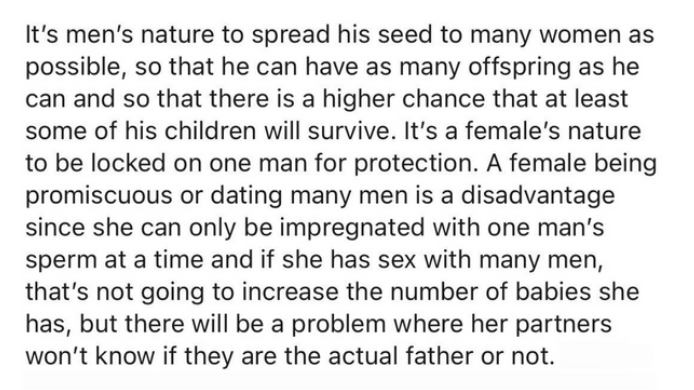You’ve probably heard some version of the following beliefs:

They justify these beliefs with pseudo-scientific, evo psych language which claims that all human behaviour is due to past selection pressures:

For example, they’ll use Bateman’s (1948) anisogamy principles. Bateman asserts that because males produce many small sperm while females produce fewer, larger eggs, their mating behaviours are different, with males mating with many females while females mate with only one male.
This assertion, based on the observations of fruit flies, has become a paradigm of evolutionary psychology, with researchers readily assuming that these observations are universal (Brown et al., 2009).
However, reviews of the insect literature have found little evidence either that male reproductive success increases invariably with number of matings, or that mate number is unimportant for females (Ridley, 1988; Arnqvist & Nilsson, 2000).
Even in fruit flies, there are reservations about the general applicability of Bateman's results (Bjork & Pitnick, 2006; Gowaty, 2003).
In fact, research has found that Bateman's principles are often overstated (Mokos et al., 2021) and his original work was methodologically flawed (Tang-Martinez & Ryder, 2005; Snyder & Gowaty, 2007).
A replication of Bateman’s study found that his method overestimated subjects with zero mates, underestimated subjects with one or more mates, and produced systematically biased estimates of offspring number by sex (Gowaty, Kim, & Anderson, 2012).
Leading these researchers to conclude that Bateman's claims about sex differences in mating and reproductive success are unfounded (Gowaty, Kim, & Anderson, 2013).
Even Bateman's own study showed that female reproductive success doesn't peak after mating with just one male. When Bateman presented his data, he did so in two different graphs. Only one graph showed female reproductive success peaks after a single mating, while the other actually indicated that more matings lead to more offspring for females:

Modern studies have demonstrated this is true in a broad range of species - females that mate with more than one male produce more young (Tang-Martinez, 2016; Gerlach et al., 2012).
As Hrdy (2000) notes, the existence of one‐male mating systems does not prove that females “naturally” gravitate to them. As with many other animals, primate females - including women - can benefit reproductively from polyandrous matings.
Understanding this can challenge narrow research solely focused on proving "universal" sex differences. For example, in a chapter for the 1997 book Feminism and Evolutionary Biology, Professor of Psychology and Zoology Charles Snowden writes:

That is to say, many scientists perceived male promiscuity and female coyness
due to prevailing theories and societal expectations.
So, when you hear folks talk about why men can have casual sex but women can’t, or that sex on the first date is different for men than it is for women, or that men are hardwired to spread their seed while women are hardwired for monogamy, et cetera ad nauseam... Remember that the seemingly “scientific” basis for these claims is shaky at best and downright unfounded at worst.
In any case, human sexuality and behaviour is much more nuanced and complicated than these biologically reductionist opinions.

